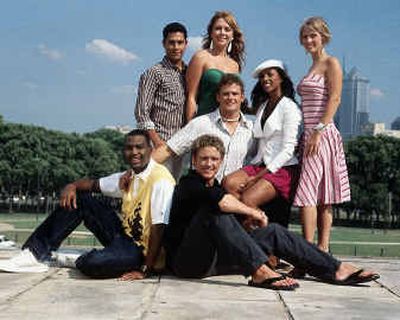Not such a ‘Real World’

It’s like a visit from old friends.
When the 15th edition of MTV’s “The Real World” — the show where “seven strangers stop being polite and start getting real”— hits the screen tonight at 10, they’ll all be there: The bumpkin. The party girl. The jock. The gay one. The black guy.
Not to mention the hookups, the breakups, the confessionals, the teary phone calls home — all of the reality-TV comfort food that has made “The Real World” a staple in a television universe where shows disappear faster than doughnuts at Homer Simpson’s house.
But if “The Real World,” this season dropping anchor in Philadelphia, is now a reality cliche — setting the IKEA-furnished stage for such corny and contrived followers as “Big Brother,” “Amish in the City” and “The Player” — it wasn’t always that way.
When the first “The Real World” landed on the air 12 years ago, it wasn’t just novel, but newsworthy, a colorful snapshot of young, urban ‘90s life that existed nowhere else on TV.
For those who showed up late to the party, “The Real World” sparked the reality-TV revolution by putting seven young adults from various backgrounds in a house for a few weeks and letting the cameras roll. Not since PBS’ groundbreaking ‘70s docu-series “An American Family,” which chronicled the breakup of a marriage and breakdown of a family in wrenching detail, had there been anything quite like it on weekly television.
That initial New York season proved to be an addictive alternative to just about any fiction the networks could crank out. The season’s strained, and sometimes hostile, racial dynamic — particularly among white and just-up-from-‘Bama Julie, African American New Yorker Kevin and white New Yorker Eric — reflected the tension of the times, a world of Rodney King, Reginald Denny, and swaying L.A. palm trees set ablaze in explosions of urban anger.
But it wasn’t just about conflict. From Norman throwing himself into Jerry Brown’s presidential campaign and dealing with his boyfriend to Andre gigging with his rock band, these roommates had a range of interests beyond partying and playing around. Who needed “Full House” when you had the “Real World” house?
Unlike the fame-hounds now dogging “The Real World,” who breeze in expecting sexcapades and sitcom deals, there was a tentativeness about those first roomies that’s now a remnant from another era, like whitewall tires and eight-track tapes.
Granted, all were involved in the arts — lending even that first season an added sense of unreality for most viewers — but at least MTV didn’t hand out cushy jobs like government cheese, as it does now. (This season’s cheddar will be provided by a Philly arena football outfit, owned by Jon Bon Jovi. The kids will be doing various tasks for the team; unfortunately none will involve blocking and tackling.)
Rivaling season one in effectiveness was season three in San Francisco, in which AIDS patient Pedro — who died not long after his shows aired — put a human face on the disease for a young audience.
But if those initial “Real World” years were like gusts of fresh air, they signaled an ill wind coming. Devolving into stereotypes and setting the tone for other reality shows, subsequent seasons upped the sex to frat-house party extremes, encouraged a general boorishness, too often portrayed male African American roomies as either militants or players, and practically turned guessing who is “the gay one” into a parlor game.
Check out the promo for “The Real World Philadelphia” on www.mtv.com. There’s Sarah, this season’s sassy girl, in a seductive pose against a shirtless MJ, this year’s rube, a college football star from Tennessee. Across them in bold letters are the words “Hookup Headquarters: Check out the new ‘Real World’ cast & tour the Philly love shack.”
Then tune into the first episode and the predictability is in full effect: Sarah rips off her bra from underneath her shirt; while all are in the hot tub, Shavonda queries, “Hookups in the house: Possibility or not a possibility?”; and MJ is preoccupied with finding out who’s gay. There is a twist, but, depending on how it plays out, it could just end up feeding into the pre-existing stereotypes.
Freed from the very real-world concern of having to find a job, this cast — as with all recent seasons — will likely just sleep late, blow off work, get paid anyway, and have more hookups than the Mustang Ranch.
It’s dispiriting to see such a pioneering program settle for formula and become just more routine reality. If the producers wanted, they could send shock waves through “The Real World” without throwing it off its axis. Here are some ways:
• Recruit roomies with life goals that don’t revolve around reality TV.
• Ditch the jobs. They don’t want to do ‘em, we don’t want to watch ‘em do ‘em, and seven untelevised people who need the work could do ‘em properly.
• Though there’s a patina of cast diversity, producers should really go out on a limb and have either a physically or mentally challenged person, or an overweight person, one season. Or maybe a mostly nonwhite cast, where the whites would feel the pressure of being the minority.
But, make no mistake, neither MTV nor its audience shows any desire for change. Several years ago “The Real World” birthed a spinoff, “Road Rules,” that put the concept on wheels. And “The Real World” now appears twice yearly, not including all those “Real World vs. Road Rules” challenges and reunions.
Last season’s “The Real World San Diego” was the highest-rated basic-cable series among 12- to 34-year-olds and was the highest-rated “Real World” ever, according to MTV.
For TV execs, that’s the real world that matters. Let the tantrums and titillation begin.